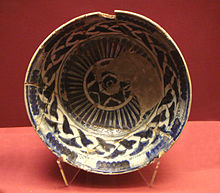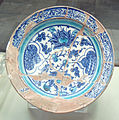- Miletus ware
-
Miletus ware is a type of pottery that was produced in various locations in Anatolia between the late 14th and mid 15th centuries.[1] The pottery was discovered through excavations in the 1930s by Friedrich Sarre at Miletus, hence the ware's name. This pottery type was not produced at Miletus, but in other towns such as İznik and Kütahya.[2][1][3]
Miletus ware used red clay as a base, covered with white slip, with simple designs in blue, turquoise and purple.[4] The design often incorporated "sunburst" and vegetal patterns.[1]
Miletus ware was superseded in the early 15th century by Iznik pottery, with the introduction of white bodies instead of the red clays. However, there is a certain continuity in the colours used for the decoration.[5]
Gallery
-
Blue and white Miletus ware. Istanbul Archaeology Museums.
Notes
- ^ a b c Muqarnas: An Annual on Islamic Art and Architecture Oleg Grabar p.53
- ^ The Cambridge history of Islam by P. M. Holt, Ann K. S. Lambton, Bernard Lewis p.734
- ^ Atasoy & Raby 1994, pp. 82-83.
- ^ Imperial Istanbul: A Traveller's Guide: Includes Iznik, Bursa and Edirne by Jane Taylor p.257
- ^ The science and archaeology of materials by Julian Henderson p.195
References
- Atasoy, Nurhan; Raby, Julian (1994) [1989], Iznik: The pottery of Ottoman Turkey, London: Alexandra Press, ISBN 978-1-85669-054-6.
Categories:- History of ceramics
- Turkish art
- Islamic art
-
Wikimedia Foundation. 2010.





